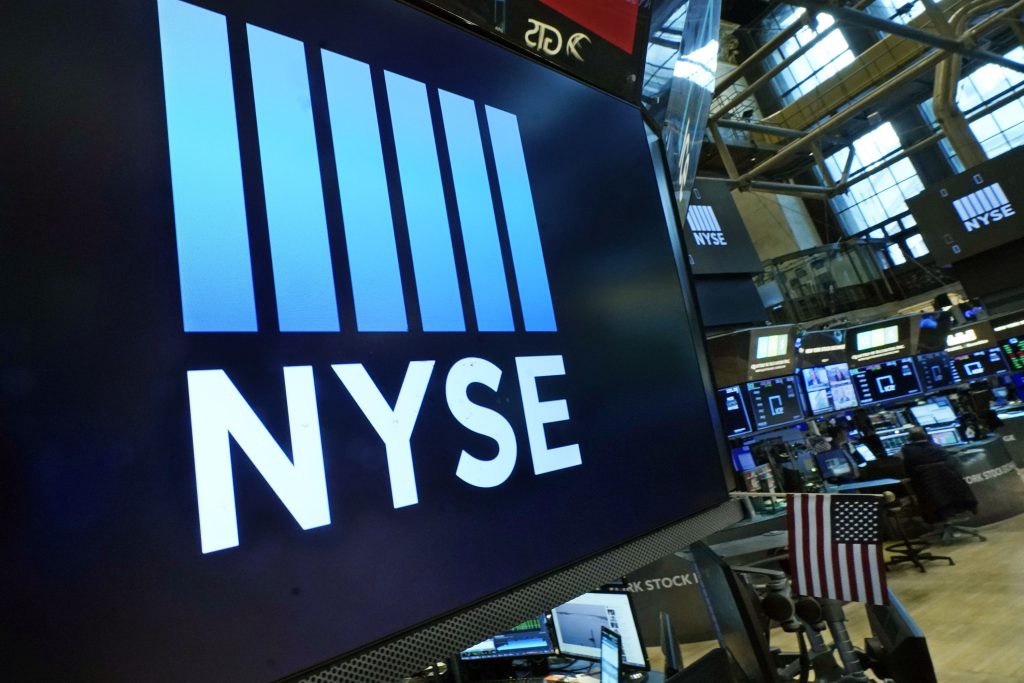Stocks slump 3% as worries grow over higher interest rates

FILE - The New York Stock Exchange logo adorn trading posts, on the floor, Wednesday, March 16, 2022. Stocks are opening lower on Wall Street Thursday, May 5, giving up some of the big gains they made a day earlier. Technology companies were leading the declines. (AP Photo/Richard Drew, File)
NEW YORK (AP) — Stocks are slumping on Wall Street, erasing a rally from a day earlier, as markets assess the looming fallout from the Federal Reserve’s stepped-up fight against inflation.
On Wednesday, the Fed raised its benchmark interest rate by half a percentage point as part of an effort to slow consumer borrowing and tamp down inflation, which is at a four-decade high. The market rallied when Fed Chair Jerome Powell dismissed the possibility the Fed could resort to a more aggressive three-quarters point hike in the future.
Now, traders are starting to fret more about the impact of the Fed’s moves to dampen demand and slow the economy.
“The Fed is between a rock and a hard place, and because of instant information investors are experiencing both fear and greed at the exact same moment,” said Sam Stovall, chief investment strategist at CFRA.
The S&P 500 was down 3.4% as of 1:49 p.m. Eastern, with more than 95% of the companies in the benchmark index in the red. The Dow Jones Industrial average stumbled 1,035 points, or 3%, to 33,024 and the Nasdaq lost 4.8%.
Bond yields resumed their upward march. The yield on the 10-year Treasury rose sharply, to 3.10%, from 2.92% a day earlier.
The Fed’s aggressive shift to raise interest rates has investors worrying about whether it can pull off the delicate dance to slow the economy enough to halt high inflation but not so much as to cause a downturn. The pace and size of interest rate increases is being scrutinized closely on Wall Street.
“Investors realized that by the Fed continuing to take a very measured approach, it could actually allow inflation to remain out of control,” Stovall said.
The latest move by the Fed to raise interest rates by a half-percentage point had been widely expected. Markets steadied this week ahead of the policy update, but Wall Street was concerned the Fed might elect to raise rates by three-quarters of a percentage point at its next meeting. Powell eased those concerns, saying the central bank is “not actively considering” such an increase.
The central bank also announced that it will start reducing its huge $9 trillion balance sheet, which consists mainly of Treasury and mortgage bonds, starting June 1. Those large holdings are a policy tool the Fed uses to keep long-term interest rates, like those on mortgages, low.
When Powell said the Fed wasn’t considering a mammoth increase in short-term rates, that sent a signal to investors to send stock prices soaring and bond yields tumbling. A slower pace of interest-rate hikes would mean less risk of the economy tipping into recession, as well as less downward pressure on prices for all kinds of investments.
But diminishing the odds of a 0.75 point hike doesn’t mean the Fed is done raising rates steadily and sharply as it fights to tame inflation, not even close. Economists at BNP Paribas still expect the Fed to keep hiking the federal funds rate until it reaches a range of 3% to 3.25%, up from zero to 0.25% earlier this year.
“We do not think this was Chair Powell’s intention,” economists at BNP Paribas wrote in a report, citing the market’s jubilance on Wednesday, “and we reckon we could see coming ‘Fedspeak’ seek to re-tighten financial conditions.”
The Bank of England on Thursday raised its benchmark interest rate to the highest level in 13 years, its fourth rate hike since December as U.K. inflation runs at 30-year highs.
Energy markets remain volatile as the conflict in Ukraine continues and demand remains high amid tight supplies of oil. European governments are trying to replace energy supplies from Russia and are considering an embargo. OPEC and allied oil-producing countries decided Thursday to gradually increase the flows of crude they send to the world.
Higher oil and gas prices have been contributing to the uncertainties weighing on investors as they try to assess how inflation will ultimately impact businesses, consumer activity and overall economic growth.
The latest corporate earnings reports are also being closely watched by investors trying to get a better picture of inflation’s impact on the economy. Cereal maker Kellogg rose 4% after reporting encouraging financial results. Etsy stumbled 17% after giving a weak forecast.
Twitter rose 3.2% after Tesla CEO Elon Musk said he had secured more backing for his bid to take over the company.
Technology companies had some of the biggest losses and weighed down the broader market, in a reversal from the solid gains they made a day earlier. Internet retail giant Amazon slumped 7% and Google’s parent company fell 4.6%.
Homebuilders fell broadly as average long-term home loan rates climbed. D.R. Horton slid 5.5%.
The average rate on a 30-year fixed-rate mortgage rose to 5.27% this week, its highest level since 2009, according to mortgage buyer Freddie Mac. A year ago, it averaged 2.96%. Mortgage rates tend to follow moves in the 10-year Treasury yield. The sharp increase in mortgage rates has strained affordability for homebuyers after years of sharply rising prices.









